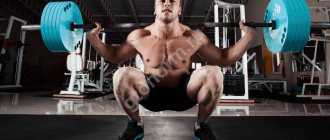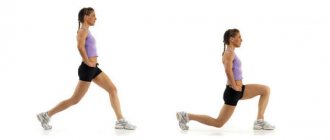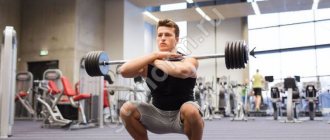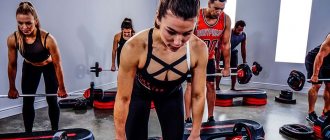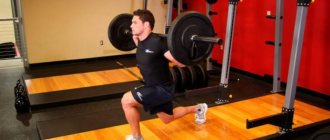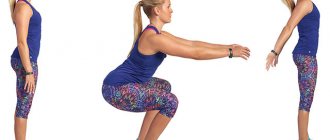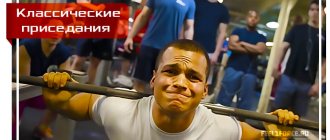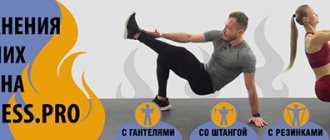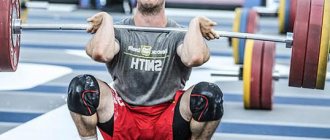The overhead squat, or overhead squat, a popular functional exercise in weightlifting, is also included in the training programs of bodybuilding, CrossFit and some related disciplines where strength development is one of the main priorities. Some even consider it the most important thing in strength training.
General principles of the exercise
Next we will talk about several variations of the exercise, but before moving on to a description of the technique of each type, we should mention the general principles of correct squats with dumbbells.
- Working out the inner thighs is facilitated by wide stance of the legs and turning the toes outward (more than 45 degrees).
- Working out the gluteal muscles is facilitated by the maximum possible range of motion (below the level of parallel with the floor).
- Working out the outer thigh is facilitated by a narrow and parallel stance of the legs.
- Working out the hamstrings is facilitated by a slight bend forward and moving the buttocks back during movement.
What muscles work
Exercises for athletes are specified by the fact that when performing a particular task, most of the muscles of the body are involved. Answering the question of which muscles work, we can say with confidence that their list is impressive,
The main ones are: muscles of the thigh, buttocks, back, calf muscles, hip biceps, quadriceps, muscles of the lower back, abs, small stabilizer muscles and the shoulder girdle. The lower the half squat, the stronger the gluteal muscles become. The chest stretches when the arms are pulled back, and coordination develops.
If you work with heavy objects for a long time, your joints and bones will become stronger. For weightlifters, strengthening these parts of the body plays a significant role in the correct execution of technique, as well as the ability to perform jerking movements. This is a good exercise for the muscles with which the knees and hips are extended, the shoulder muscles are trained,
Stop placement and load
The high and narrow position of the feet transfers the load to the biceps of the thighs and buttocks, but only people whose thigh is approximately the same length as the lower leg can safely squat in this position. If you are not one of them, you should be more careful in selecting exercises. It is better to take the option with your back to the gym, and not to the back of the machine;
“Sumo” allows you to shift the load to the medial heads of the quadriceps, but in most cases this technique also includes the adductor muscles;
The anatomical stance distributes the load between the quadiceps and biceps relatively evenly.
Leg exercises. Hack squats.
Watch this video on YouTube
Common mistakes in squats
The feet are parallel to each other.
The placement of the feet corresponds to the width of the shoulders. Socks point to the sides.
Head position in squats
The gaze is directed downwards.
It is necessary to look just above the horizon to maintain a safe position of the spine. But under no circumstances throw your head back as high as possible.
Squat depth
Do partial squats to shorten the range of motion.
Squat to parallel to engage more leg muscles and take pressure off your knees.
Knee position in squats
Knees point forward or inward.
The knees are spread to the sides. This takes the load off them and ensures the optimal position of the body parts.
Correct execution is the key to effective results
Each version of squats with a barbell or dumbbells has its own technique of execution, which gives results, but one way or another you need to start by consolidating the technique of simple squats with your own weight. The most common mistake is to squat too deeply and lower the dumbbells to the floor. To protect yourself from injuries, especially at the initial stage, it is better to do traditional squats until your buttocks are parallel to the floor
This is especially important if you are overweight or plan to work with weights. Over time, when the muscles and tendons adapt to the loads, it will be possible to master the technique of performing deep squats and switch to exercises with a barbell
Below are the basic rules for performing and features of classic squats:
You need to keep your back straight, do not rock your body, lowering should be done smoothly, without sudden movements. It is important to keep the abdominal muscles in constant tension for additional fixation of the spine and maintaining the position of the back. The stronger the press, the greater the chance of preventing injury during execution. Before squats, you should definitely warm up, working your knees and ankles. In a classic squat, keep your feet shoulder-width apart, constantly monitoring the position of your knees, which should not protrude beyond your toes. You need to squat without lifting your feet from the floor, transferring the weight to the middle of the foot
If it is difficult to perform the exercise without lifting your feet, then you can use special bars that can be placed under your heels. Unweighted squats can be done in large quantities every day. There are even programs in which a person must squat at least 1000 times in one day. If you experience pain or crunching in your knees during exercise, you should consult your doctor to determine the underlying cause.
In conclusion, we note that squats give a noticeable positive effect and the benefits for the body are obvious, both with and without weights with multiple repetitions every day. By combining squats with proper nutrition and other exercises, you can achieve a significant increase in muscle mass and endurance. When squatting, always remember that there must be a limit and too much enthusiasm for the exercise can lead to overtraining of the body. Don’t forget about recovery, plan your daily load correctly and the effect will not take long to arrive.
Author Peter Ivanov
It is important to realize that if squats for 3, 5, 10, 12 repetitions to failure develop the muscles of the legs and back and promote mass growth, then squats for quantity are more likely to contribute to endurance training and are able to burn this very mass!
Squat technique
Before starting the exercise, adjust the height of the racks. The bar should be located just below your shoulders so that you don’t have to stand on your toes when removing the bar.
- Stand under the barbell, place the bar on the trapezius muscles (there is a photo below). Grasp the bar on both sides as narrowly as possible so that the bar is stable on your back.
- Remove the bar from the racks and take a few steps back. Make sure your feet are positioned correctly.
- Take a deep breath and slowly squat down to parallel.
- After a short delay, stand up and exhale.
- Complete the required number of repetitions.
- Return the bar to the racks.
Now we have looked at the basic technique of squats, but this exercise has many nuances that are reflected in typical mistakes.
Relief from tight ankles
To get a full range of motion, you need enough dorsiflexion at the bottom of the squat to keep your heels off the floor. Limitations in dorsiflexion can be very visible in the squat, and these limitations can occur due to injury (new or old), or improper footwear (heels, orthotics) are some reasons.
Roll your calves and feet
You can use a foam roller, although I prefer to use a baseball or a barbell as they are a little denser and make the rolling deeper. Simply sit on the floor with a roller or ball under your games. Now you can lift yourself up with your arms and roll the entire length of your calf, or you can find the sore spot and make circles to really get to it.
Ankle flexion mobility
The initial position will be the same as the hip flexor stretch in the video above, except the stick should be a couple of inches to the side of your big toe. Then, without allowing the heel of your front foot to leave the ground, lean forward so that your knee moves towards the stick. When you can no longer do this without your heel lifting off the ground, move forward so that your knee is slightly outside the pole, continue to lean forward as far as you can without your heel lifting up. Do about ten repetitions, you may need to do this on both sides but not necessarily, it all depends on your problems
Varieties of squats with a barbell
In addition to the classic squat with a barbell on the shoulders, there are many variations of this exercise.
Front squats with barbell
An option when the athlete holds the apparatus not on his shoulders, but on his chest. This exercise is used in weightlifting and is considered less traumatic than the classic squat with a barbell on the shoulders.
Sumo squat with barbell
Sumo differs from the classic squat in the position of the feet; they spread widely and turn outward. This option is often used in training by powerlifters. It shifts the load to the inner thighs and buttocks, unloading the quadriceps. It is often used in female bodybuilding, because the fair sex does not need overly pumped quadriceps, unlike convex buttocks and toned inner thighs.
Zercher Squats
A rarely used option is squats, named after the Canadian athlete Zercher, who proposed this exercise back in the 30s of the last century. They differ from the classics in that the barbell is held in front of the body on the elbows. This option gives maximum load on the quadriceps; it is good for beginners, since with this position of the weight you involuntarily have to keep your back straight, which is one of the main requirements of the squat technique.
Hackenschmidt squats
An almost completely forgotten option is squats with a barbell in lowered hands behind the body. This exercise works the triceps well and puts minimal stress on the spine, but now it is practically not performed; it has been replaced by squats in the hack machine.
Overhead squats
One of the exercises used in crossfit and weightlifting. When performing it, in addition to the muscle groups involved in the classic version, the shoulders and especially the stabilizer muscles are also loaded, because holding the weight above the head requires their maximum tension. This option can only be recommended for people with a high level of physical fitness and without problems with joints and spine.
Single leg barbell squats
The maximum load on the muscles without increasing the weight of the barbell can be achieved by performing a squat on one leg. When performing this squat, the barbell is held on the shoulders, as in the classic version, one of the legs is bent at the knee and placed on a support standing behind. Such squats, compared to classic ones, load the muscles twice as much, which makes it possible to reduce the weight of the projectile and reduce the axial load on the spine.
Fix hips
Poor hip mobility is most often created due to poor postures and movements that are performed very frequently, which have led to muscle imbalances and poor range of motion in the hip joint. At the bottom of the squat, you need to flex your hip quite a bit. If this range is limited, you may not even sit down to parallel.
Rolling the buttocks and Piriformis
Sit on the roller and place your right ankle on your left knee. Lean slightly to the right and roll the entire buttock area. Do the same for the left side.
Hip opening
Extend your hips to work toward the extreme end of your hip flexion range. Stand in a deep lunge with your back leg straight and your knee flat on the floor. Place your hand on the inside of your front leg, press your foot toward the floor, and use your elbow to push your knee outward. Then shift your body weight to your front knee to really work the end of the range. Do this for about a minute and repeat on the other side.
You must progress in this exercise in order to do the same in the pigeon stretch. Make sure you don't just hold the position, but move your body to and from your front leg to work the end of your hip flexion range.
Hip flexor stretch
My favorite stretch. All you need is a stick or foam roller. Watch this video for information.
Do deep squats help pump up muscles better?
It is difficult to say which squat depth puts more stress on the muscles of the hips and buttocks, since science does not provide an exact answer.
In two Muscle Activation Differences Between Partial and Full Back Squat Exercise With External Load Equated. , Muscle Activation Differences between Three Different Knee Joint‑Angle Positions during a Maximal Isometric Back Squat Exercise. Studies have found that a partial squat puts more strain on the buttocks, hamstrings, and calves than a deep squat. In another A Comparison of Gluteus Maximus, Biceps Femoris, and Vastus Lateralis Electromyography Amplitude in the Parallel, Full, and Front Squat Variations in Resistance‑Trained Females. did not see any difference between muscle activation in squats with different depths.
Another study, The effect of back squat depth on the EMG activity of 4 superficial hip and thigh muscles, showed that when you squat deeply, your gluteal muscles engage more during the rise than if you perform the exercise until your thighs are parallel to the floor or higher.
There are two possible explanations for this:
- Muscles are under load longer. More mechanical tension, stimulus for growth, strength and hypertrophy.
- When a muscle is loaded in a stretched position, Neuromuscular adaptations associated with knee joint angle‑specific force change increase. mechanical stress and growth. The deeper you squat, the more the medial and lateral heads of the quadriceps and gluteal muscles will stretch, which means training will be more effective and muscle growth will be faster.
However, this does not mean that every person needs to squat as deep as their knees bend. The ideal depth of a squat is different for everyone, and it depends primarily on the ability to maintain the correct technique.
Do deep squats damage cartilage?
It is logical to assume that excessive pressure on the knee joint wears down the meniscus and cartilage behind the kneecap. However, elite weightlifters and powerlifters suffer from osteoarthritis no more often than Degenerative joint disease in weight‑lifters. Fact or fiction? than non-athletic people. But they train every day and lift a barbell many times their body weight.
Exercises performed through the full range of motion, that is, when you bend your limbs as far as possible, on the contrary, help protect joints, and strength training has been shown to The Effect of High Resistance Weight Training on Reported Pain in Older Adults even with osteoarthritis. They help strengthen muscles, reduce pain and restore mobility.
So, a deep squat does not have a negative effect on the knee joints. But does it make sense to squat like this, unless, of course, you do weightlifting?
Rules for performing barbell squats without equipment at WPF-KRAWA competitions
Despite the fact that the standards for squats for men and women vary quite a lot, taking into account weight categories and physiological characteristics, there are uniform rules according to which an attempt can be invalidated. We are talking about the following points:
- The athlete is obliged to carefully monitor the commands given by the chief judge, following them accurately. Accordingly, failure to comply with the commands results in immediate cancellation of the attempted attempt.
- Only one attempt to stand up with the set weight is allowed; repeated attempts, even if successful, cannot lead to a positive error.
- No mistakes are allowed in the final stage of the movement, when all that remains is to fix the knee joint in the on state.
- After taking the starting position, the bar should be in a stationary and unchanged position along the squat. Its displacement leads to failure.
- Regarding the movement of the feet during a squat, everything is prohibited except for rocking from toe to heel and back.
- Assistants have the right to touch the bar only in very specific situations. If assistance from an outsider is detected, the attempt is automatically considered unsuccessful. Depending on the circumstances, the athlete may be eligible for an additional attempt.
- It is prohibited to touch your legs with your elbows or shoulders, as this is regarded as a gross violation of the technique of performing the movement.
- Any mistakes made during the stage of returning the barbell with weight to the racks to complete the attempt.
Some athletes prefer a very wide grip, but sometimes this carries some dangers. The fact is that touching the disks or locks with your hands during the attempt leads to its cancellation and this must not be forgotten.
